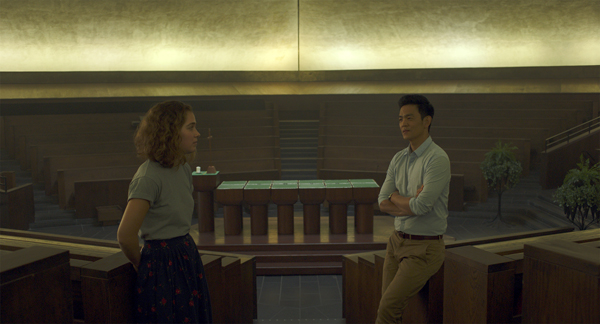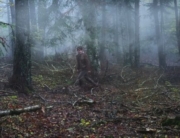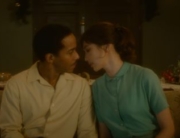This quiet yet slowly engrossing drama takes place in the Midwestern town of Columbus, Indiana, which becomes a magnet for two dissimilar people. Jin (John Cho), a grown man from South Korea, has spent much of his adult life estranged from his father, only to be drawn back, resentfully, to the latter’s side. By contrast, Casey (Haley Lu Robinson), a young woman in her late teens, has spent her whole life attached to the hip with her mother, resisting opportunities to pull away. The two characters are moving in opposite directions, and the film is about the brief interval during which their paths intersect.
The catalyst is Jin’s father, a famous architect who has come to Columbus to give a lecture when he becomes seriously ill. The son flies in from Seoul, presumably to either bring him home or to be by his side at the end, but he finds his father in a stable, albeit comatose condition. Jin is in limbo. All he can do in the meantime is pass the time, either by hanging out at the upscale bed-and-breakfast where his father had been staying or by wandering about town, which features a large number of mid-century modernist buildings.
As for Casey, she works part-time at the library, where she would like to land a full-time job but is short several credentials—indeed, she has not even gone off to college. What has kept her around is her mother (Michelle Forbes), who is a recovering crystal meth addict, for whom Casey fears the worst would happen if she were to leave, as well as the allure of the local architecture. Her knowledge of all the town’s trend-setting buildings and world-renown architects instantly reminds Jin of his ailing father.
A friendship grows between two people who feel stuck where they are. Casey offers Jin a tour of her top 20 favorite buildings, while he tries to convince her to accept a scholarship to study in the Northeast. Their pairing works because Jin, like Casey, is not quite the picture of a settled adult, despite the fact that he’s considerably older than her. Though he’s on the phone with Seoul quite often, there are no loved ones or even friends back home that he’s trying to reach. He also nurtures an unrequited crush on his dad’s longtime assistant (Parker Posey), who makes recurring appearances and offers Jin her condolences, if not much else.
Casey, meanwhile, has heaped more responsibility upon herself than is typical of someone just one year removed from high school. As her and Jin’s relationship deepens, and they start revealing to the other just how stressed and/or frayed their respective parental bonds are, there are times that Casey seems like the older and wiser of the two.
Columbus marks the directorial debut of Kogonada, and one of his central motifs is the relationship between his characters and their environment. It constantly seems as if the landscape affects the protagonists, instead of the other way around. Throughout Casey’s architectural tour, she and Jin often find themselves staring at wondrous edifices as they loom in either the near- or middle-distances, both intimidated into temporary silence. There are also instances in which their most basic interactions seem mediated by the landscape. Their first-ever meeting takes place with a wrought iron fence between them, which forces them to walk along on opposite sides of it until they can find a gap.
It’s a very subtle form of restriction, and while Jin and Casey might not be outright rebels, they do stand out from their surroundings. One of the first times Casey takes notice of Jin is when he’s by himself, speaking Korean into his phone. Meanwhile, Casey’s new acquaintance might be the first person she’s met to see more in her than just a walking encyclopedia of architectural knowledge. The key moment occurs as they’re standing before a startlingly all-glass building originally designed as a bank, by Eero Saarinen in the 1950s: Jin asks her to not just recite facts about it but to explain why the building moves her so profoundly. What’s important isn’t the content of what Casey says, and, indeed, Kogonada makes the choice to not let us to hear any her response. What matters are her opinions and that Jin wants to know what they are.
Cho, who hasn’t played the lead in many films, much less serious dramas, acquits himself well as Jin, who is at turns serious and charming. Posey and Forbes are effective in supporting roles, as is Rory Culkin as Casey’s only friend at the library. But it’s Richardson who is the real discovery. As Casey, she manages the tricky balancing act of playing someone with the weight of the world upon her shoulders, but who hasn’t lost her intellectual curiosity.
Overall, Columbus is recommended to those interested in leisurely-paced, character-driven art house fare. It’s a very still movie in which the protagonists’ lack of physical action disguises the profound changes that occur within them. As audience members, watching the film is like gazing at the aforementioned modernist buildings in the town itself: they’re aesthetically pleasing, but what’s more important are the emotions they arouse, which in this case include empathy and even a little admiration.

















Leave A Comment